The Future of TCU's Alumni Population
A study of seniors' post-graduation locations.
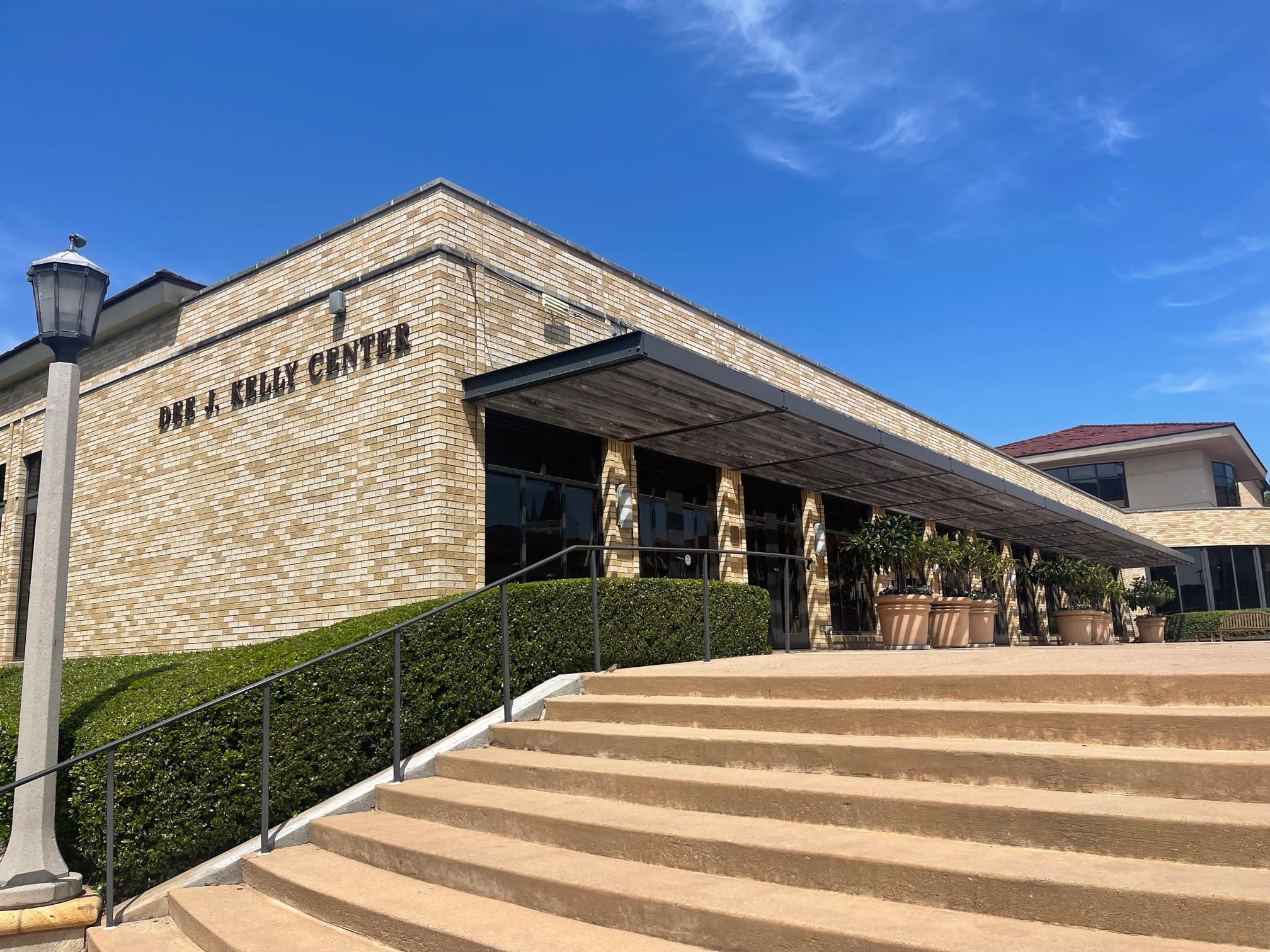
Walking through the airport in a purple TCU hat, or even this year’s signature HypnoToad sweatshirt, you can expect to hear “Go Frogs” from a passerby or exchange the just-as-common Horned Frog hand signal with someone on your flight. It seems like TCU fans are everywhere.
Similarly, in this year’s College Football Playoffs, Frog fans showed up in comparable numbers to their Michigan and Georgia rivals, both of which have an undergraduate enrollment of about three times the size of TCU. While many factors contributed to fan attendance numbers, one of the reasons that a small, private university was able to fill the Scottsdale and Los Angeles stadiums is because its alumni population exists in significant numbers outside of Texas.
TCU’s alumni base, though a fraction of the size of public universities, is populated in every major city throughout the country.
According to data provided by the TCU Alumni Association, out of 86,821 counted alumni, 57,945 currently live in Texas. California has an alumni population of 3,927 and Colorado has a population of 2,020.
Another significant statistic is that 1,208 TCU alumni have a foreign address. Not only do Horned Frogs find opportunities in the United States, but the university is represented across the globe.
The top five states that have purchased National Championship tickets on SeatGeek:
— Front Office Sports (@FOS) January 4, 2023
1️⃣ Texas - 37% of sales
2️⃣ California - 19% of sales
3️⃣ Georgia - 7% of sales
4️⃣ Michigan - 3% of sales
5️⃣ Arizona - 3% of sales pic.twitter.com/tzbw67xjgG
Thomas Brown, Director at the TCU Alumni Association, explained how the alumni population is organized by city and how the association connects with former Horned Frogs. (Ella Gibson)
Thomas Brown, Director at the TCU Alumni Association, explained how the alumni population is organized by city and how the association connects with former Horned Frogs. (Ella Gibson)
A Look at the Statistics
According to data published by Handshake in 2022, 54 percent of students who attend college in the South stay in the region after graduation. The study found that the most popular cities that students move to outside of the region are New York, Washington D.C., Chicago and San Francisco.
When compared to a 66 percent retention rate in the Midwest, 76 percent retention in the Northeast and 78 percent retention in the West, it seems that students are more eager to move out of southern states as soon as they walk the stage.
The 2022 Axios-Generation Lab Next Cities Index surveyed 506 Americans from ages 18 to 24 and published that the top destination city for this age group was Seattle, followed by New York and Los Angeles. These results changed based on income level, political party and gender.
A study, Examining the Interstate Mobility of Recent College Graduates, explained that many states and public universities implement programs to reduce “brain drain,” or the population of students who move to the state to attend college but relocate soon after graduating. Texas has a higher retention rate than other southern states, some of which experience a net loss of college graduates moving to and from their state.
Calling all international students! Join us to hear from TCU international alumni and learn steps to successfully navigate your internship/job search as an international student. Registration required on Handshake! https://t.co/Qq58A6Le8G pic.twitter.com/dqnbTGsnHz
— TCU Career Center (@TCUCareerCenter) December 6, 2020
Though states aim to keep students in the area, many prestigious universities prioritize a diverse admissions pool over retention rates of students post-graduation.
According to TCU Admissions, while only 40 percent of Horned Frogs are from Texas, 55 percent attend the university from other states and the last 5 percent is made up of international students from over 75 countries.
Method
TCU made its way onto the national stage this year, most notably through its football team’s appearance in the Fiesta Bowl and National Championship. Generations of Horned Frogs across the country made their voices heard in support of the university’s academic and athletic success.
While data and experience show that our alumni base exists in strong numbers across each region of the nation, the goal of this study was to examine trends among this year’s graduating class to understand where TCU seniors are deciding to live in the year following graduation.
An online survey was sent to graduating seniors in the class of 2023. The survey consisted of anonymous multiple choice and short answer questions about students’ college and major, hometown and post-graduation plans. Interviews were conducted with staff at the TCU Alumni Association and TCU Center for Career & Professional Development.
Where are TCU seniors moving after graduation and why?
Results
The survey yielded 46 responses from students across a variety of colleges.
Bob Shieffer College of Communication had the highest response rate of 21.7 percent while Neeley School of Business had a similar response rate of 26.1 percent. Harris College of Nursing had a response rate of 13 percent. Six other colleges were represented.
While only 13 respondents were originally from DFW, 26 respondents are planning on living in the area after graduation. This data reveals a significant increase in the amount of students living in the region around TCU after graduation. Other cities that students plan to move to include Elkins, NM; New York, NY; Sioux Center, IA and San Diego, CA, among others.
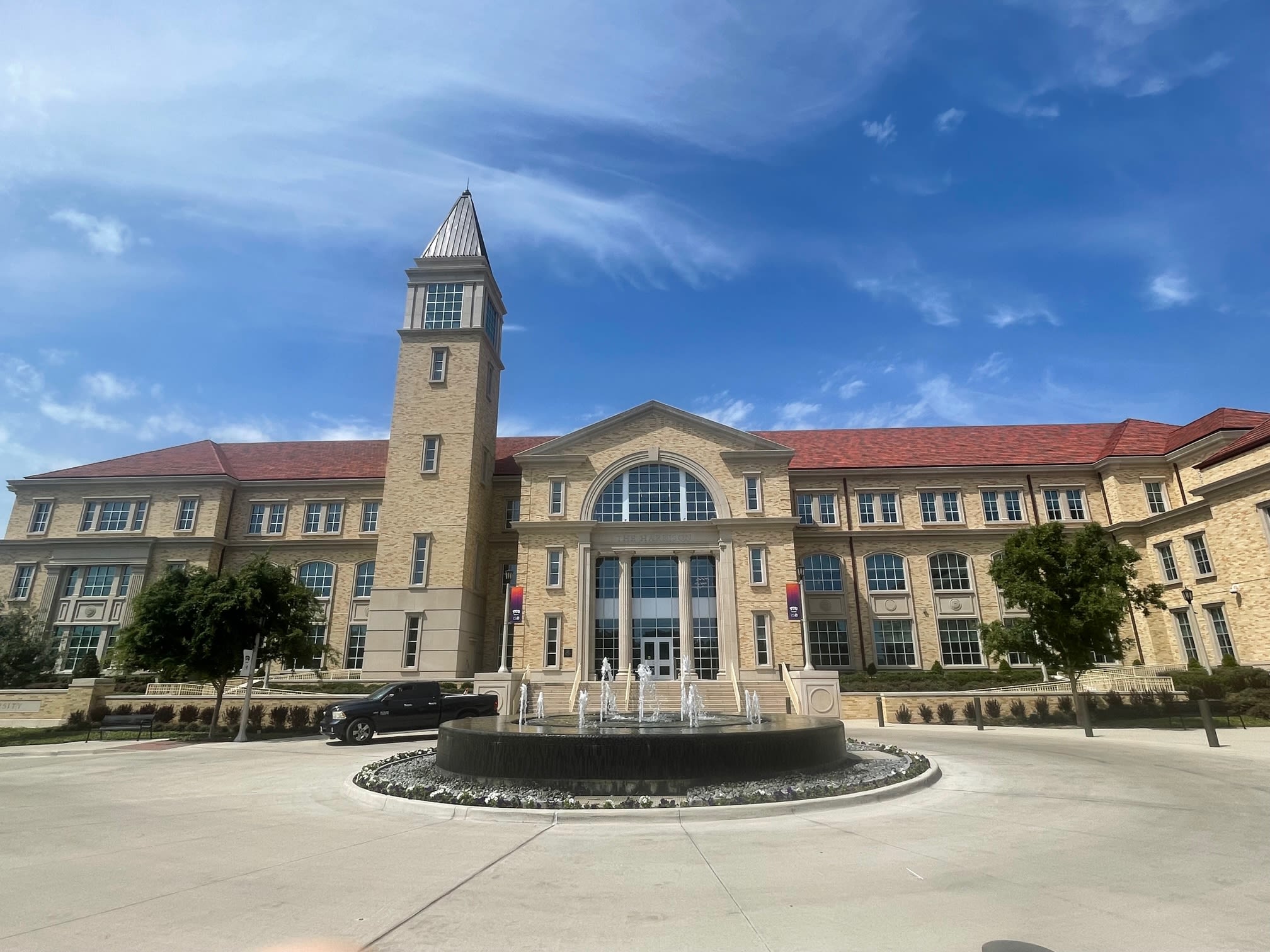
The survey questions that followed provided an understanding of these results.
When asked the reason for living in said location after graduation, over half of the respondents said their job was the deciding factor. In response to a question about graduation status, 65.2 percent of respondents reported their status to be "employed full-time" and 4.3 percent reported their status as "employed part-time."
Around a quarter of respondents answered that their reason was the proximity to friends or family and around 15 percent of respondents answered with "graduate school."
Results from the 2022 Graduate Exit Survey, conducted by the Office of Student Life Analytics, showed that 39.7 percent of graduating seniors reported their status as “employed full-time” last year. The survey had 1,626 participants. Last year’s survey also published that there had been a full-time employment increase of 4.4 percent from 2021.
There was a drastic increase in reported full-time employment between the 2022 Graduate Exit Survey and the survey conducted for this study. This may be explained by a smaller pool of respondents. Regardless, the most common status among seniors in the past three years has been “employed full-time” and this status is only becoming more frequent.
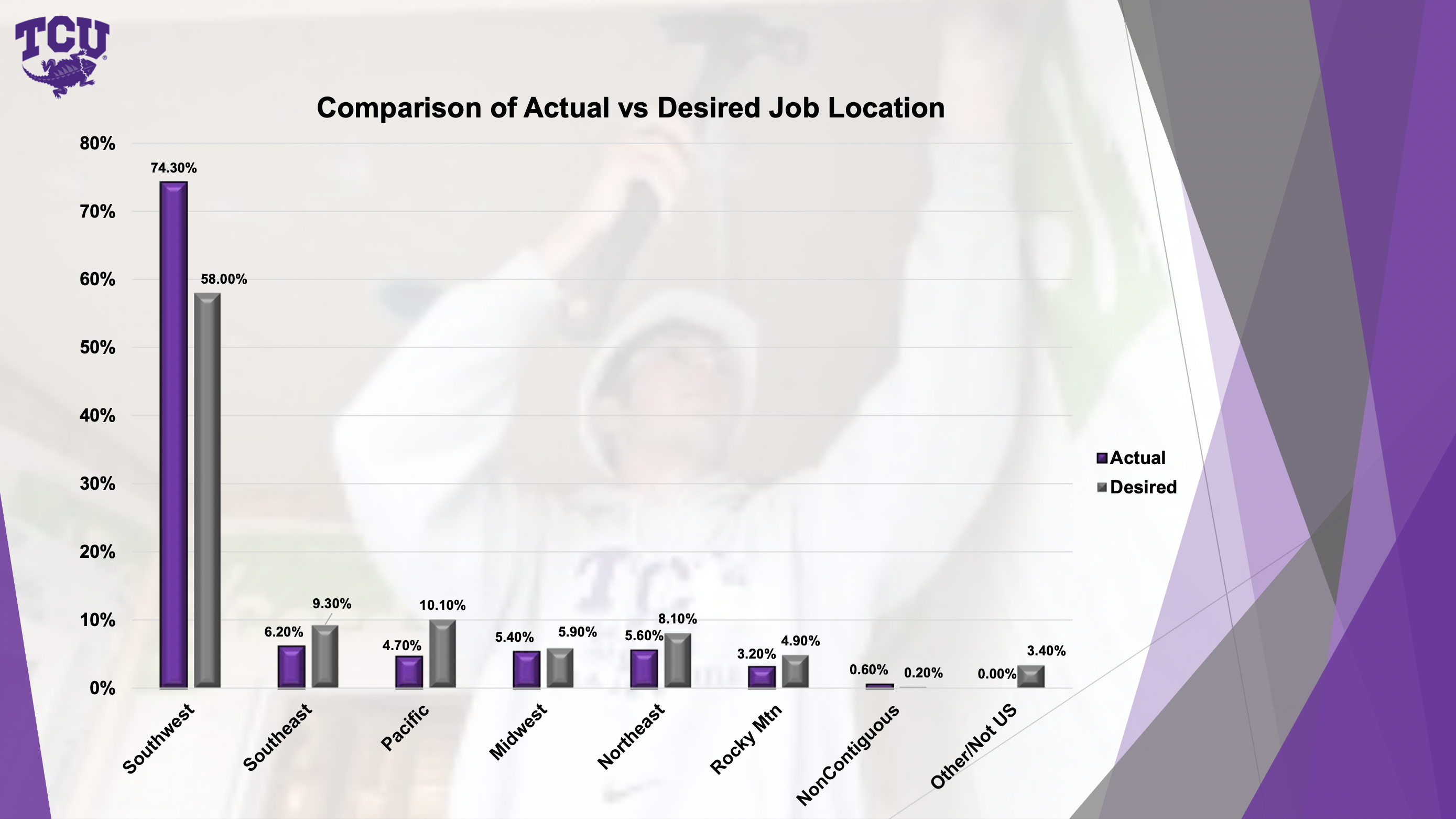
Graph from the Spring 2022 Graduate Exit Survey overview, comparing graduating senior's actual and desired job locations. Photo courtesy of the Office of Student Life Analytics.
Graph from the Spring 2022 Graduate Exit Survey overview, comparing graduating senior's actual and desired job locations. Photo courtesy of the Office of Student Life Analytics.
Another significant result from the survey was that about half of the respondents answered that they plan to live in their specified location for two to five years. Around 30 percent of participants plan to stay in a location for more than five years and fewer students plan to stay for less than a year.
Horned Frogs Set Up for Success
When examining the upward trend of students following career positions after graduation, it is important to look at the TCU Center for Career & Professional Development and how its services impact student opportunities.
Mike Caldwell, the Executive Director at the TCU Center for Career and Professional Development, explained the resources that the center provides. Staff members facilitate individual and group advising, which can include resume assessments and job search mentoring. The center also issues job listing and interview preparation materials. One of the most valuable roles of the career center is to create relationships between students and employers.
The center provides “connection to employers and alumni for networking and job opportunities via career fairs, networking events, industry info sessions and employer recruiting events,” Caldwell said. “Services are also available to alumni for life.”
Additionally, students may have access to Intern Scholarship and Career Readiness funds that can provide aid to reach career goals.
The Future of TCU's Alumni Population
The Executive Director also shared that TCU has a “net gain” of students staying in Texas after graduating, which supports results from this study. Other popular cities include Austin, Houston, New York, Chicago, Nashville and many locations in California, according to Caldwell.
“Last year, at graduation, 74 percent of graduating seniors reported working in the Southwest region, including Texas,” Caldwell said. “We see a slight trend upward in students continuing to stay in Texas, given the growth in employers and jobs in our area.”
More students are staying in Texas for career opportunities, which may impact future alumni numbers in the state, specifically in the DFW area. As a result, out-of-state admission numbers may decline because students have fewer alumni connections in their respective states.
Despite increasing numbers of recently-graduated students in the area, results show that the majority of students only plan to stay in their chosen location for less than five years. This may mean that students will decide to move back to their home states, closer to family and friends or another location in the country after a few years. In this case, alumni numbers across the country will remain fairly consistent.
“TCU has a lot of ‘name recognition’ outside of the state,” Caldwell said. “Employers also report feedback that TCU hires are great additions to their teams. This helps build new and continued opportunities for students to land great employment options.”
TCU has connections across the country and a prestigious reputation attached to it. Though more students have been drawn to stay in DFW in recent years, Horned Frogs will never stop making an impact across the globe.
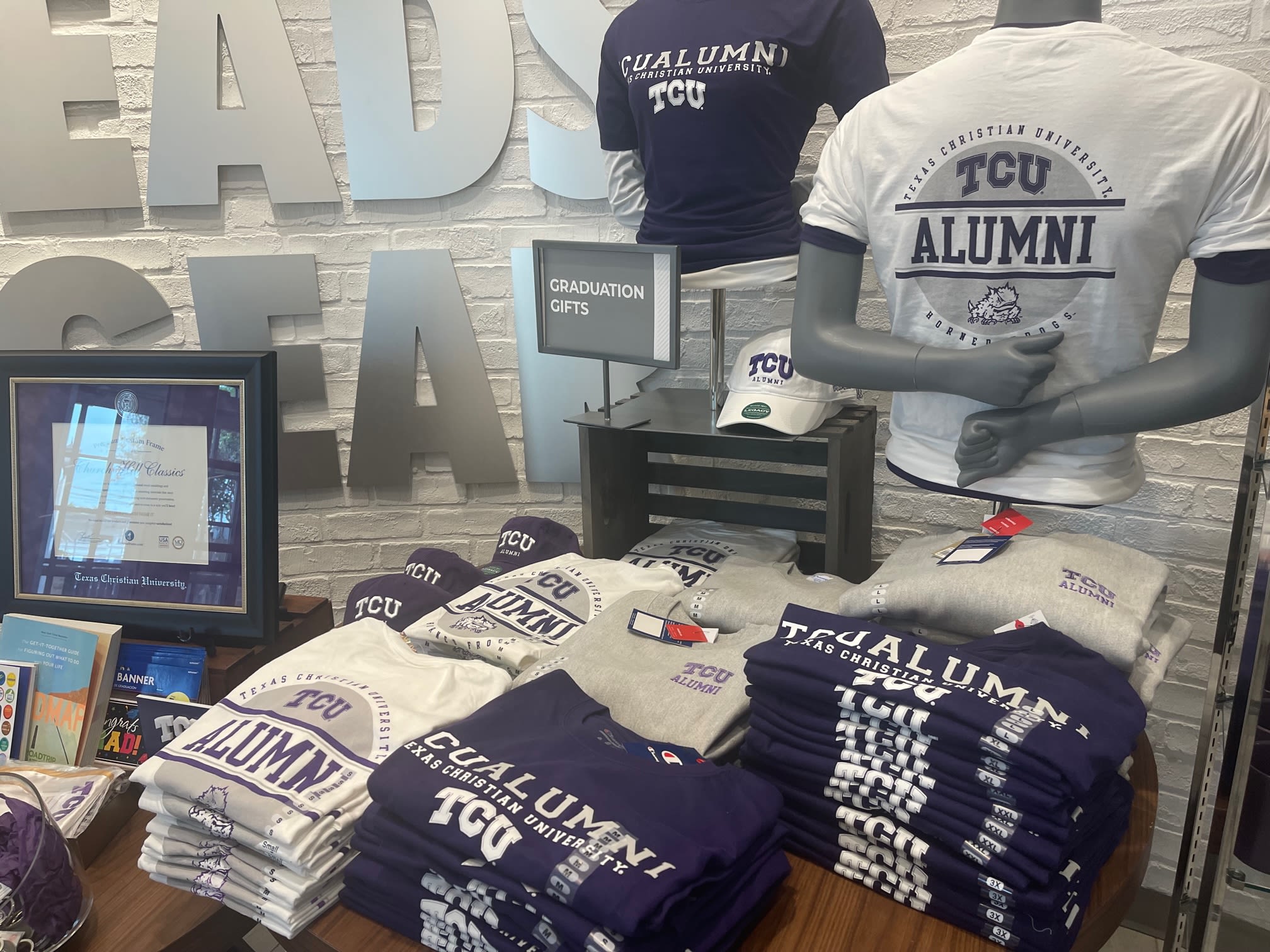
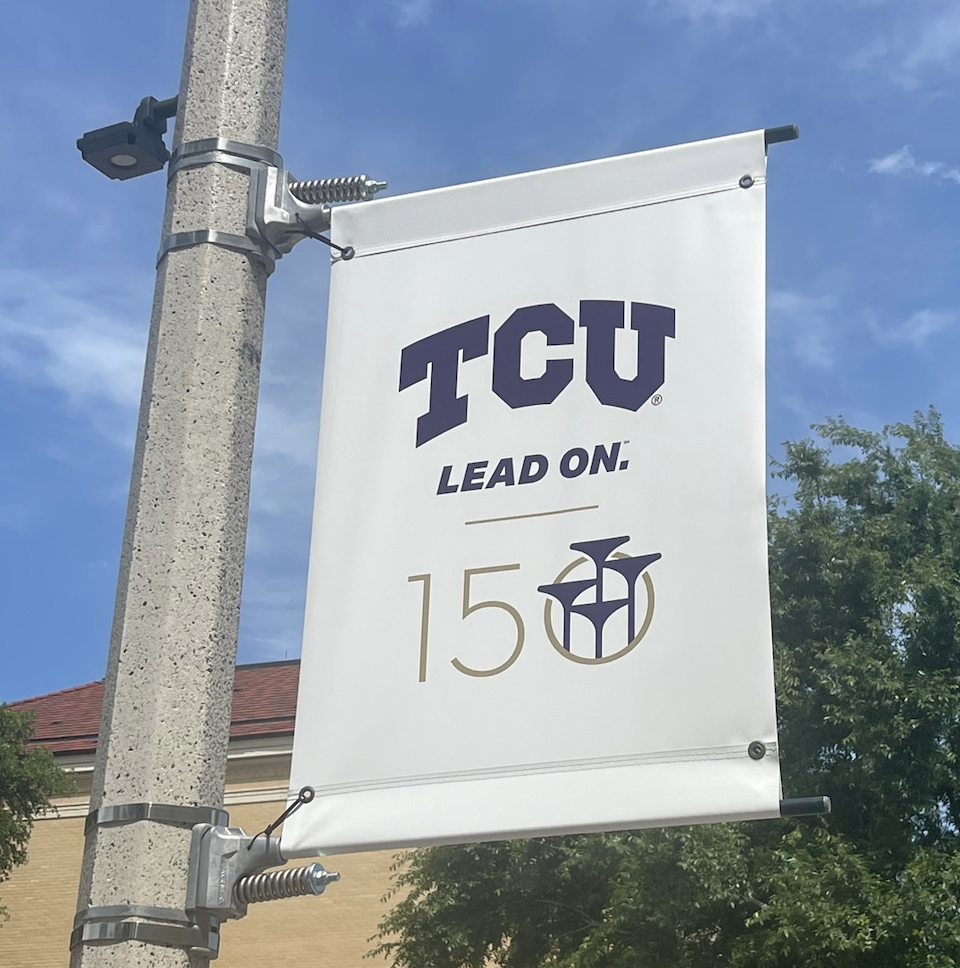
References
Beschloss, Cyrus. “2022 Axios-Generation Lab ‘Next Cities Index.’” The Generation Lab, 14 Mar. 2022, https://www.generationlab.org/post/nextcities.
“Frequently Asked Questions.” Undergraduate Admissions, 13 Sept. 2022, https://admissions.tcu.edu/apply/faqs/index.php#accd22e72-where-are-tcu-students-from.
“Frog for Life.” Texas Christian University, https://alumni.tcu.edu/new/.
Kelchen, Robert, and Douglas A. Webber. "Examining the Interstate Mobility of Recent College Graduates." Educational Researcher, vol. 47, no. 3, 2018, pp. 213-215.
“Plan Now for Your Career Development.” Center for Career Professional Development, https://careers.tcu.edu/.
“TCU Student Life Analytics.” Student Life Analytics, https://analytics.tcu.edu/.
“Where Are College Students Going after They Graduate?” Handshake, 2 Sept. 2022, https://joinhandshake.com/blog/employers/where-are-college-students-going-after-they-graduate/
